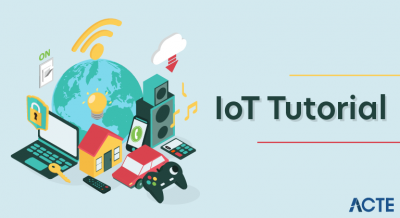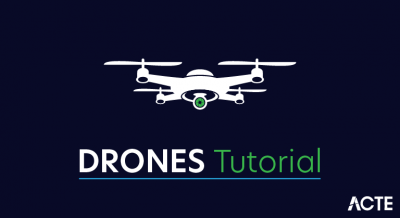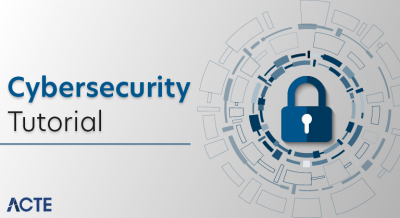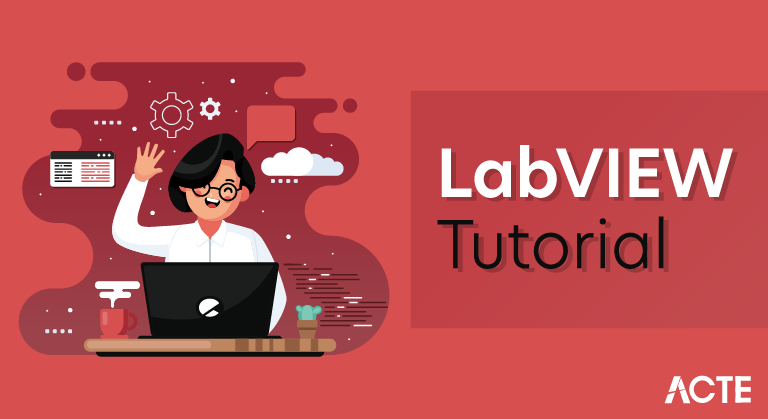
LabVIEW – Industrial Programming
Laboratory Virtual Instrument Engineering Workbench (LabVIEW) is a system-design platform and development environment for a visual (graphical) programming language from National Instruments. This is a Complete Labview online course, which takes you from zero to an advanced level, where you will be able to create your own programmes and understand other codes as well. LabVIEW solves engineering challenges across a broad range of application areas. Hence it is an indispensable skill to have.

INDUSTRIAL Overview:
Many startups use LabVIEW for rapid prototyping, building breadboards and proof of concept systems prior to building the final shipping products. LabVIEW is especially valuable for companies who want to ship complex systems that need all of the embedded software, FPGA software and client applications for the same product as LabVIEW allows developing the whole stack in a single high-level language cutting the total development cost and time significantly. In addition, many companies use it for testbeds, R&D tools and manufacturing and service tools for hardware products that were developed using some other embedded programming languages.
Industries :
- NASA
- ARAI
- Automotive industries
- Biomedical sector
PROGRAM Objective:
It is an easy-to-use, interactive, graphical programming language that is ideal for engineers and scientists. Whether you are an educator or a student, knowing how to program in it is a valuable skill with many benefits.
What are the learning outcomes?
This is a Complete Labview online course, which takes you from zero to an advanced level, where you will be able to create your own programs and understand other codes as well. You can put your skills to test with a minor project and major project. (Major project will be a workshop in a Makerspace with mentors). It solves engineering challenges across a broad range of application areas.
What are the main highlights of the program?
- Learn without a career break with online classes available 24*7.
- One can access the course at their own pace, but with the investment of 3-5 hours/week, it can be finished within a month.
- The program uses a Continuous Evaluation System that assesses the learners over convenient and regular intervals. Such a system provides timely and frequent feedback and helps busy working professionals stay on course with the program.
- The education delivery method is a blend of classroom and experiential learning.
- Participants who will complete the program become eligible for Mentorship and Placement help through our Job Fairs.
How to enrol?
- Signup with your operational e-mail ID.
- Select the “LabVIEW – Industrial Programming”.
- Select “Take the Course”.
- Apply coupon code if applicable.
- Fill the required fields on the form.
- Select your preferred payment gateway.
- Pay the total amount.
- Select “Start Course” and shift yourself to an upskilling mode.
Who should apply?
The program is designed for students or professionals who are:
- This Labview online course is meant for anyone who is interested in learning programming with it as a whole. No prior programming knowledge is needed.
- Programming enthusiasts
- Students, Researchers, and Engineers in the field of mechanics of electronics, robotics, mechatronics, industries, medicine, and industrial automation
What are the technical requirements?
The program to give its best will need the following requirements:
- Computers/ Laptop will provide you with the best experience, but this program is quite compatible with smartphones to make it feasible for students worldwide.
- High-speed internet for crystal clear experience, but this program can also run without buffering with below-average connectivity for reaching out to students from suburban and rural areas.
- A student should make their notes for future reference.
- A student should have basic knowledge about high-school physics, maths, and chemistry, even though the prerequisite of this program will brush up one’s basic concepts.
- A computer or laptop – With Windows 7 or later, > 2Gb of RAM (4Gb Recommended), 1.5Ghz Processor or higher (Multicore Core 2Ghz processor Recommended).
- LabVIEW Software in trial version or you can purchase a license.
Core LabVIEW Concepts
- LabVIEW Environment Basics—Examine the most important building blocks for any LabVIEW application, including the front panel, block diagram, palettes, controls, and indicators.
- Graphical Programming Basics—See how to connect functions and work with a variety of data types when constructing applications.
- Common Tools—View a collection of important tools and common user functions that all users should know.
- Debugging Tools—Learn how to use simple tools and techniques to understand the behavior of code and address problems or bugs.
Programming in LabVIEW
- Data Structures—arrays, clusters, and enumerated data
- Execution Structures—While Loops, For Loops, and Case structures
- Passing Data Between Loop Iterations—shift registers
- Handling Errors—error handling and error clusters
- Finding Examples and Getting Help: Finding Examples—Example Finder and ni.com/code/Using the LabVIEW Help—context help and the LabVIEW Help/Online Help Resources—KnowledgeBase and forum.
What is the programming language used in LabVIEW?
The programming language used in LabVIEW is called “G”, (G stands for graphical). Usage of LabVIEW increases productivity as it takes considerably less time to develop applications when compared to the traditional programming languages. Using traditional programming languages, it takes about weeks to months accomplishing the development tasks. The same tasks can be completed within less amount of time by using the powerful graphical programming language.
Benefits of LabVIEW :
In this section, the users will be able to understand the benefits that are associated with LabVIEW.
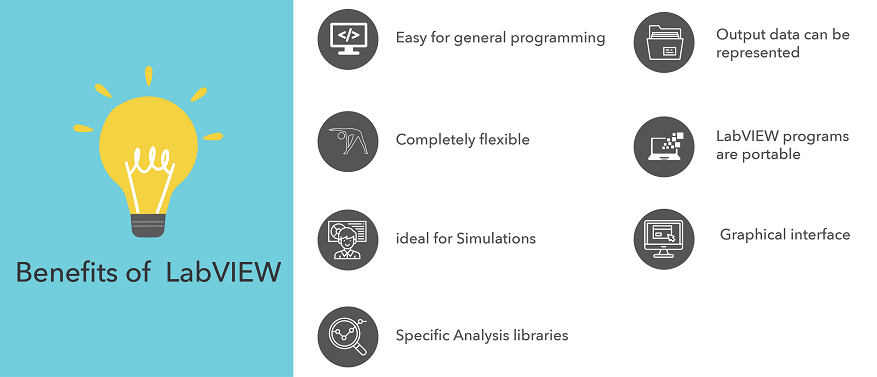
With the help of user intuitive graphical interface of LabVIEW, users will be able to avail the following benefits:
- Having a graphical interface makes LabView easy for programming.
- It is ideal for Simulations
- A user will be able to present how the data flow happens within a virtual instrument.
- Easy for general programming
- Basic programming concepts can be taught.
- Completely flexible in terms of creating a virtual instrument according to your requirements.
- You can easily modify the virtual instruments as and when a change is needed.
- Has extensive libraries of functions and subroutines. These can be used for programming tasks. Thus, eliminating the fuss of having pointers, memory allocation, and often troubles that occur with a traditional programming language.
- Contains specific libraries that are related to Data acquisition (DAQ). These libraries are useful for data analysis, data presentation, data storage and ultimately communication.
- LabVIEW has specific Analysis libraries which have useful functions like signal generation, signal processing, filters, windows, and regression. All these are used for analysis.
- The output data can be represented in any graphical format, i.e. charts, graphs etc.
- LabVIEW programs are portable, i.e. you can write a program in Mac and then execute it in Windows Machine and vice-versa.
Dataflow and the Graphical Programming Language:
In this section, we will discuss the programming language that is used in LabVIEW and how the dataflow is represented graphically.
- The program development efforts related to LabVIEW are different compared to the standard development, which is nothing but text-based programming where developers use predefined text syntax.
- When it comes to LabVIEW programming, the coding is carried out using a graphical programming language, which is often called “G”. Using this language, programs are created using pictorial forms which in turn are called “Block Diagrams”.
- Using a graphical programming language, the developers will be able to achieve the tasks in a short duration of time, and at the same time don’t have to bother about adding semicolons, curly braces, etc.
- With the use of graphical programming, the developers will be able to focus on the data flow within the application.
In the below screenshot, you will be able to see the graphical interface of LabVIEW.
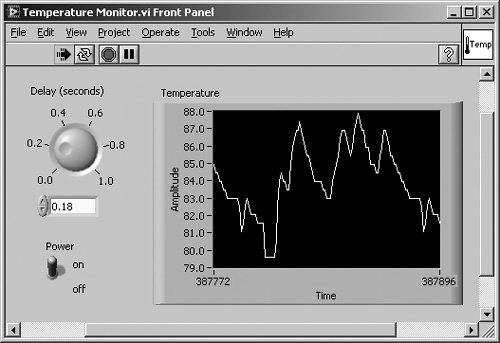
Future Scope of LabVIEW
LabVIEW is a powerful tool where most of the organizations who are into Industrial Automation, Engineering, Research & Development use this software to build prototypes and proof of concepts before building the final product.
Job Opportunities & SalariesLabVIEW
Software, PathWave BenchVue Software, or LabVIEW. Now Hiring both, Part-Time & F… Job Title – Manufacturing Technician A 1st shift. The Production Technician will.Labview Salaries in the United States. Popular Jobs Average Salary is listed below;
- Electrical Engineer 8,016 salaries reported Electrical Engineer Jobs $91,734 / year
A lot of Startups are actually using this software to build complex systems as it reduces the amount of development effort in total. Also, the use of LabVIEW software is predominant in the areas where hardware products are built based on embedded programming languages.
The demand for LabVIEW developers has always been high in the current market. Most of the companies are providing solutions in terms of Industrial automation and household automation.

Components of Virtual Instrument
A virtual instrument (VI) has three main components, they are :
- Front panel
- Block diagram
- Icon
Labview terminology vs Conventional Languages:
Whereas other programming systems use text-based languages to create lines of code, LabVIEW uses a graphical programming language to create programs in a pictorial form called a block diagram, eliminating a lot of the syntactical details.
Laview Terminology:
- VI ( Virtual Instrument)
- Function
- Sub VI (Sub Virtual Instrument)
- Front panel
- Block Diagram
- G
Conventional Language terminology:
- Programm
- Function or method
- Subroutine, subprogram or an object
- User interface
- Program Code
- C, C++, Java, Basics etc.
Error Handling in LabVIEW:
Error handling is an essential part of a professional LabVIEW application, however is something that is often overlooked. Without adequate error handling applications can be hard to debug, provide a bad user experience and in the worst case can cause damage to equipment, loss of data and even injury.When starting out with LabVIEW one of the first things we are taught is the importance of error handling. In these early days the general advice is that we should always enclose block diagram code in an error case and that we should always wire errors between our subVIs. However, in practice this advice does not always provide an adequate error handling strategy when creating professional applications, and in some circumstances causes more problems than it solves.
Local Error Handling
Often when an error occurs, rather than passing it downstream it can be dealt with there and then. How you handle the error depends on the specific error and the software requirements. Often when an error occurs we might decide to handle it locally by one of three ways; ignore it, modify it, or retry.
Ignore
Sometimes it is possible to simply ignore an upstream error. One common example might be a communications timeout error when reading from a TCP connection. In the case of a timeout the read VI returns an error because it failed to successfully carry out its primary job, however in the context of your application this might not be seen as an error and therefore it can be cleared (for example it could be that there are no messages to read).
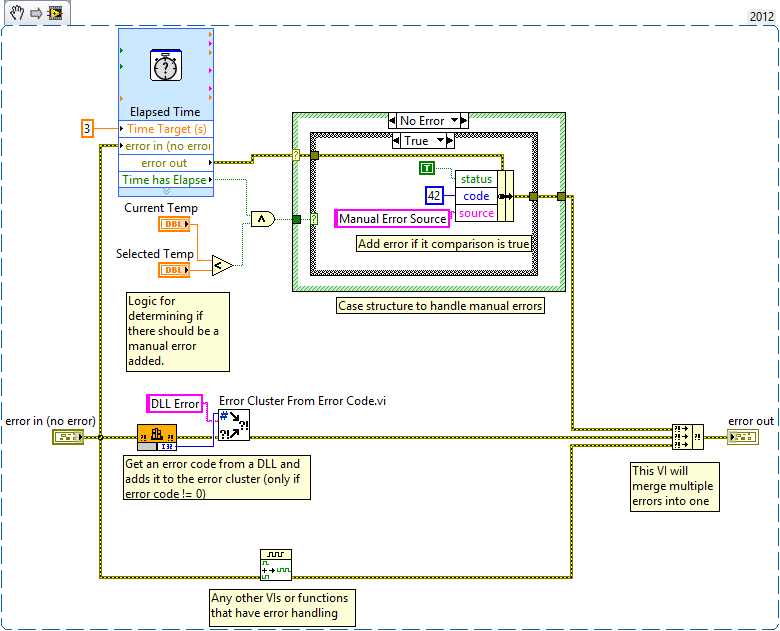
Modify
Some errors may provide information that can be used downstream, even if you do not consider them to be errors. In this case you could choose to downgrade an error to a warning. In this case the error cluster retains the useful information, however does not prevent downstream code from executing. One example would be when creating a new directory: if the directory already exists an error will be generated, however if the reason you are creating the directory is simply to ensure that it exists then you might not want an error to be generated.

Another reason you might want to modify an error is to change the error code to one specific to your application.
Retry
Sometimes you might only be interested in an error if it occurs a number of times. An example might be when attempting to initialise a DAQ device when the device has not been connected. In this example you might clear the error and then retry.
Asynchronous Error Handling
You might not always want to handle errors locally and therefore it might be necessary to pass error information to another module to be handled. In this case you can use queued message handlers if you have a dedicated error handling module, or by user events if you want modules (for example a state controller or user interface) to subscribe to error messages.
In practice you are likely to use a combination of local and central error handling depending on the requirements of your project.Error handling in LabVIEW follows the dataflow model. As the VI runs, LabVIEW tests for errors at each execution node. If LabVIEW does not find any errors, the node executes normally.
Conclusion:
Cytokinetics has built and maintains an automation software infrastructure using in LabVIEW. The language has proven to be a powerful tool to create both rapid prototype applications as well as an entire framework for system integration and process execution.Hope you have found all the details that you were looking for, in this article.

